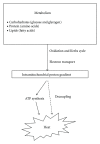Brain temperature: physiology and pathophysiology after brain injury
- PMID: 23326261
- PMCID: PMC3541556
- DOI: 10.1155/2012/989487
Brain temperature: physiology and pathophysiology after brain injury
Abstract
The regulation of brain temperature is largely dependent on the metabolic activity of brain tissue and remains complex. In intensive care clinical practice, the continuous monitoring of core temperature in patients with brain injury is currently highly recommended. After major brain injury, brain temperature is often higher than and can vary independently of systemic temperature. It has been shown that in cases of brain injury, the brain is extremely sensitive and vulnerable to small variations in temperature. The prevention of fever has been proposed as a therapeutic tool to limit neuronal injury. However, temperature control after traumatic brain injury, subarachnoid hemorrhage, or stroke can be challenging. Furthermore, fever may also have beneficial effects, especially in cases involving infections. While therapeutic hypothermia has shown beneficial effects in animal models, its use is still debated in clinical practice. This paper aims to describe the physiology and pathophysiology of changes in brain temperature after brain injury and to study the effects of controlling brain temperature after such injury.
Figures
Similar articles
-
The epidemiology of spontaneous fever and hypothermia on admission of brain injury patients to intensive care units: a multicenter cohort study.J Neurosurg. 2014 Oct;121(4):950-60. doi: 10.3171/2014.7.JNS132470. Epub 2014 Aug 8. J Neurosurg. 2014. PMID: 25105701
-
Cooling the injured brain: how does moderate hypothermia influence the pathophysiology of traumatic brain injury.Curr Pharm Des. 2007;13(22):2310-22. doi: 10.2174/138161207781368756. Curr Pharm Des. 2007. PMID: 17692002 Review.
-
Brain-systemic temperature gradient is temperature-dependent in children with severe traumatic brain injury.Pediatr Crit Care Med. 2011 Jul;12(4):449-54. doi: 10.1097/PCC.0b013e3181f390dd. Pediatr Crit Care Med. 2011. PMID: 20711083 Free PMC article.
-
Combating hyperthermia in acute stroke: a significant clinical concern.Stroke. 1998 Feb;29(2):529-34. doi: 10.1161/01.str.29.2.529. Stroke. 1998. PMID: 9472901 Review.
-
[Cellular metabolism, temperature and brain injury].Ann Fr Anesth Reanim. 2009 Apr;28(4):339-44. doi: 10.1016/j.annfar.2009.02.016. Epub 2009 Mar 19. Ann Fr Anesth Reanim. 2009. PMID: 19303246 Review. French.
Cited by
-
Induced Hypothermia Does Not Harm Hemodynamics after Polytrauma: A Porcine Model.Mediators Inflamm. 2015;2015:829195. doi: 10.1155/2015/829195. Epub 2015 Jun 11. Mediators Inflamm. 2015. PMID: 26170533 Free PMC article.
-
Emerging Trends in the Use of Therapeutic Hypothermia as a Method for Neuroprotection in Brain Damage (Review).Sovrem Tekhnologii Med. 2021;12(5):94-104. doi: 10.17691/stm2020.12.5.11. Epub 2020 Oct 28. Sovrem Tekhnologii Med. 2021. PMID: 34796010 Free PMC article. Review.
-
Linking Hypothermia and Altered Metabolism with TrkB Activation.ACS Chem Neurosci. 2023 Sep 6;14(17):3212-3225. doi: 10.1021/acschemneuro.3c00350. Epub 2023 Aug 8. ACS Chem Neurosci. 2023. PMID: 37551888 Free PMC article.
-
Immune involvement in the pathogenesis of schizophrenia: a meta-analysis on postmortem brain studies.Transl Psychiatry. 2017 Mar 28;7(3):e1075. doi: 10.1038/tp.2017.4. Transl Psychiatry. 2017. PMID: 28350400 Free PMC article.
-
Impact of Infection on Stroke Morbidity and Outcomes.Curr Neurol Neurosci Rep. 2016 Sep;16(9):83. doi: 10.1007/s11910-016-0679-9. Curr Neurol Neurosci Rep. 2016. PMID: 27485944 Review.
References
-
- Shigemori M, Abe T, Aruga T, et al. Guidelines for the Management of Severe Head Injury, 2nd edition guidelines from the Guidelines Committee on the Management of Severe Head Injury, the Japan Society of Neurotraumatology. Neurologia Medico-Chirurgica. 2012;52(1):1–30. - PubMed
-
- Cairns CJ, Andrews PJ. Management of hyperthermia in traumatic brain injury. Current Opinion in Critical Care. 2002;8(2):106–110. - PubMed
-
- Fernandez A, Schmidt JM, Claassen J, et al. Fever after subarachnoid hemorrhage: risk factors and impact on outcome. Neurology. 2007;68(13):1013–1019. - PubMed
-
- Greer DM, Funk SE, Reaven NL, Ouzounelli M, Uman GC. Impact of fever on outcome in patients with stroke and neurologic injury: a comprehensive meta-analysis. Stroke. 2008;39(11):3029–3035. - PubMed
-
- Alberts B, Johnson A, Lewis J, Raff M, Roberts K, Walter P. Molecular Biology of the Cell. 4th edition. Garland Science; 2002.
LinkOut - more resources
Full Text Sources



